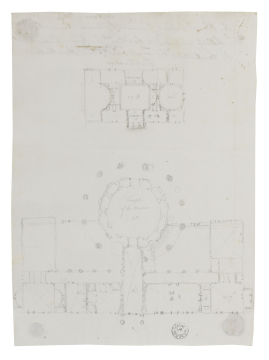Inscribed
Inscribed in pencil in a contemporary hand Temple / of the Muses and measurements verso Inscribed in ink in a contemporary hand at Rome 1762 / This British Capital Invented by James Adam Architect/ is humbly presented to the Hon'ble Sir James Gray Bart/ by the Author[deleted] His most obed't & obliged Serv the Author/ Explanation / Explanation
Signed and dated
- Undated, probably after 1763verso 1762
Medium and dimensions
Pencil274 x 200
Hand
James Adam
Verso
Sir James Gray (c.1708-1773) was the British ambassador to Naples at the time of James Adam's visit in 1762 and it was to him and Sir Francis Eyles in Rome that Adam showed his Parliament scheme in October 1762 (see J. Fleming, Robert Adam and His Circle in Edinburgh & Rome, London, 1962, p.301). This intended explanation was probably to have been produced on the latter occasion; there are versions of it in the Clerk Collection, Scotland (see J. Harris, Catalogue of British Drawings for Architecture, Decoration, Sculpture and Landscape Gardening 1550-1900 in American Collections, New Jersey, 1971, p.3). The drawing for the Capital referred to is in Adam vol.7/69
James Adam described this capital in 1762 as follows: 'Lions and unicorns alternately support the angles of the abacus, sustaining themselves on the acanthus leaves, their hinder parts, converted into chimeras, form twenty stalks that produce roses and thistles. The middle of the capital is adorned with a sceptre bearing the dove (the emblem of peace), over it the crown of Britain, instead of the Corinthian rose, and on the under part or moulding of the abbacus is the collar of the Order of the Garter. This capital is modelled in wax and bronzed and has altogether the air antique, and has surprised everybody that has seen it...' (see J. Fleming, Robert Adam and His Circle in Edinburgh & Rome, London, 1962, p.306). In the Clerk Collection, Scotland there are two draughts for the dedication to the King: 'Description of my Capital 1762. This British order invented at Rome by JA. Archt. & intended for principal portico of a parliament house design'd by him at Rome 1762 most humbly presented to H.M. The king by his subject & servt the Author' (see J. Harris, op.cit. , 1971, p.3). There are also chalk sketches for a similar order in Adam vol.7/13 and 193, and a version of this drawing, also by Antonio Zucchi (1726-95), in Prints and Drawings, Metropolitan Museum, New York, USA and another one in the Avery Library, Columbia University, USA (see Harris, op. cit., p.3).
The capital was also engraved in Rome by Domenico Cunego (1727(9) - 94) for The Works in Architecture of Robert and James Adam, London, 1773-79, part V, pl.2, as after James Adam, 1767: 'We have formerly, that the ancients used very frequently to indulge themselves in compositions of fancy; introducing into their capitals and entablatures the various symbols of those divinities to whom they erected temples. A licence of the same has been hazarded here. The lion and unicorn support the angles of the abacus, which is adorned with the regal crown, the collar of the order of the Garter, and acorns in ovolo. The sceptre and dove, the rose and thistle, fill the intermediate space between the leaves of the acanthus. The lion and unicorn are also alternatively interwoven in the foliage of the freeze, and the oak-leaf and acorn again adorn the upper torus of the base.'
James Adam intended the capital for the columns of the portico of his Parliament House scheme, and he referred to them in 1762 as 'for the great portico of my project' (see National Archives of Scotland, Edinburgh, Clerk of Penicuik Collection, GD18/4936). Giovanni Battista Piranesi (1720-1778), in his Trofei di Ottarviano Augusto, 1753, offered several antique sources for such a composition, especially that of San Lorenz fuori delle Mura. The capital also appears in the portrait of James Adam of 1763 by Antonio Zucchi (1726-95).
Watermark
Dove on monti within single circle
Notes
These plans are probably connected with James Adam's work in the Adam London Office, after 1763.
Level
Drawing
Exhibition history
The Adam Brothers in Rome: Drawings from the Grand Tour, Sir John Soane's Museum, London, 25 September 2008 - 14 February 2009
Digitisation of the Drawings Collection has been made possible through the generosity of the Leon Levy Foundation


